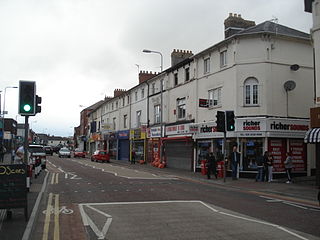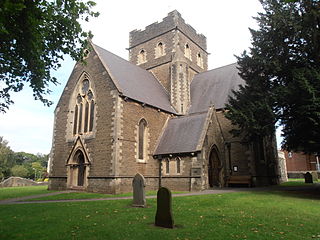
Congregationalism is a Reformed (Calvinist) tradition of Protestant Christianity in which churches practice congregational government. Each congregation independently and autonomously runs its own affairs. These principles are enshrined in the Cambridge Platform (1648) and the Savoy Declaration (1658), Congregationalist confessions of faith. The Congregationalist Churches are a continuity of the theological tradition upheld by the Puritans. Their genesis was through the work of Congregationalist divines Robert Browne, Henry Barrowe, and John Greenwood.
The Tabernacle (משכן), or Tent of the Convocation according to the Book of Exodus, was a movable tent and worship facility used by the Israelites.

The Evangelical Presbyterian Church in England and Wales (EPCEW) is a reformed and conservative evangelical Presbyterian denomination based in England and Wales with churches in Germany, Switzerland, and Sweden. Founded in 1996, the denomination is small.

Canton is an inner-city district and community in the west of Cardiff, capital of Wales, lying 2 miles (3.2 km) west of the city's civic centre. It is located adjacent to Pontcanna. Canton is one of the most ethnically diverse of Cardiff's suburbs, with a significant Pakistani and Indian population. The total population of Canton increased to 14,304 at the 2011 census. It is also the most Welsh-speaking district of central Cardiff, with 19.1% of the population speaking Welsh.
The United Reformed Church, Hamilton, Scotland, is made up of two congregations which merged in 1966. The older congregation originally met in a building at Back o’ Barns, and was founded (1807) under the guidance of the Reverend Greville Ewing, who was instrumental in founding many such independent churches in Scotland, and also the Scottish Congregational College. That congregation eventually settled in Auchingramont Road, and in its latter form was known as St. James’ Congregational Church. Due to a theological dispute a small number of members left that congregation and formed a church which eventually met in South Park Road. This congregation originally associated itself with the recently founded Evangelical Union of Scotland.

St Margaret's Church is a nineteenth-century Church in Wales parish church in the suburb of Roath, Cardiff, Wales. It includes the mausoleum of the Marquises of Bute.

Habershon & Fawckner or Habershon, Pite & Fawckner was a British architectural practice active in England and Wales from the 1860s, particularly in Cardiff and the South Wales area. They had had offices in London, Cardiff and Newport, designing a large number of houses, villas and non-conformist chapels.

Parkminster United Reformed Church is located in Roath, Cardiff.

Albany Road Baptist Church is a Baptist church located in Roath, Cardiff, Wales.

St. Andrew's United Reformed Church is a 19th-century United Reformed church located in the Roath area of Cardiff, Wales. The church is situated on the corner of Wellfield Road and Malborough Road, with some referring to it as the 'church on the corner'. The church covers the ministry areas of Roath and Penylan.

St Martin's Church is an Anglican church on Albany Road in Roath, Cardiff, Wales.

St Anne's Church, Roath is a disused church on the corner of Snipe Street and Croft Street, in Roath, Cardiff, Wales. It closed in 2015 after 128 years of worship.

St Peter's Church, Roath is the oldest surviving Roman Catholic church in Cardiff, the capital of Wales. It is administered by the Rosminians.

The Shah Jalal Mosque, officially the Shah Jalal Mosque & Islamic Cultural Centre is a listed place of worship in Cardiff, Wales. Originally built for Methodist Christians, it ceased as a church in the 1980s and is now a mosque. It is affiliated to Bangladeshi Sufi Fultoli movement.

Tredegarville Baptist Church is a Baptist chapel in the suburb of Roath, Cardiff. It was established to reach Roman Catholics with the Gospel.

Trinity Methodist Church, now the Trinity Centre, is a Grade II listed former Methodist church in Adamsdown, Cardiff, Wales.

The Weybridge United Reformed Church situated at Queen's Road, Weybridge, near to its junction with York Road, is a Victorian Grade II Listed church building that is now no longer used as a place of worship.





















